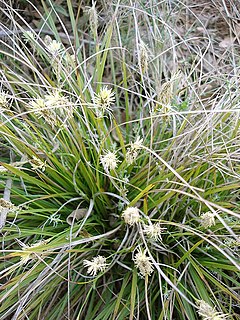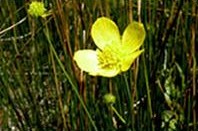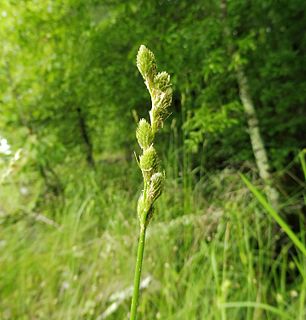
In botanical nomenclature, a form is one of the "secondary" taxonomic ranks, below that of variety, which in turn is below that of species; it is an infraspecific taxon. If more than three ranks are listed in describing a taxon, the "classification" is being specified, but only three parts make up the "name" of the taxon: a genus name, a specific epithet, and an infraspecific epithet.

Ornamental grasses are grasses grown as ornamental plants. Ornamental grasses are popular in many colder hardiness zones for their resilience to cold temperatures and aesthetic value throughout fall and winter seasons.

Vitis aestivalis, the summer grape, or pigeon grape is a species of grape native to eastern North America from southern Ontario east to Maine, west to Oklahoma, and south to Florida and Texas. It is a vigorous vine, growing to 10 m or more high in trees. The leaves are 7–20 cm long, suborbicular, and usually a little broader than long; they are variable in shape, from unlobed to deeply three- or five-lobed, green above, and densely hairy below. The flowers are produced at every 3rd node in a dense panicle 5–15 cm long. The fruit is a small grape 5–14 mm diameter, dark purple or black in colour. It is the official state grape of Missouri. Summer grape prefers a drier upland habitat.

Carex is a vast genus of more than 2,000 species of grass-like plants in the family Cyperaceae, commonly known as sedges. Other members of the family Cyperaceae are also called sedges, however those of genus Carex may be called true sedges, and it is the most species-rich genus in the family. The study of Carex is known as caricology.
Earina aestivalis is a species of orchid that is endemic to the North Island of New Zealand. The specific epithet, aestivalis, is derived from Latin and means "pertaining to the summer".

Adonis aestivalis, the summer pheasant's-eye, is a medicinal and ornamental plant. It is native to Europe but has been introduced elsewhere, such as the western and eastern parts of the United States. The specific epithet, aestivalis, is derived from Latin and means "pertaining to the summer".

Spiranthes aestivalis, commonly called the summer lady's-tresses, is a species of orchid found in western Europe, Turkey, Russia, and North Africa. The specific epithet, aestivalis, is derived from Latin and means "pertaining to the summer".
Acne aestivalis also known as acne mallorca, is a special kind of polymorphous light eruption induced by ultra violet A radiation. This condition is said to be seasonal, usually affecting people in the spring time and goes away in the fall time when there is less sun light. This photo induced skin reaction leads to a monomorphous eruption that consists of multiple, uniform, red, popular lesions. This skin reaction is classified as a delayed-type hypersensitivity because the onset is 24–72 hours after sun exposure. The condition equally affects men and women between the ages of 20–40 years old with no prior history of acne vulgaris. The eruption is unusual because it spares the face but it affects the lateral aspects of the upper arms, shoulder girdle, back, and chest. This condition’s pathogenesis is not very well understood but scientists believe it an unfortunate side effect that results from a strong immune response to potentially cancer-causing cell damage.

Liatris aestivalis, also known as the summer gayfeather, is a plant species in the aster family Asteraceae and genus Liatris. The specific epithet, aestivalis, is derived from Latin and means "pertaining to the summer". It is native to Oklahoma and Texas in the United States, where it is found in habitats that range from limestone outcrops to slopes and bases of slopes with shallow soils.

Carex vesicaria is an essentially Holarctic species of sedge known as bladder sedge, inflated sedge, and blister sedge. It has been used to insulate footwear in Norway and among the Sami people, and for basketry in North America.

Bovista aestivalis is a small puffball in the family Agaricaceae. It is generally found in the coastal regions of California, but was reported from Korea in 2015. This fungus is often confused with Bovista dermoxantha, because of its similar peridium, and Bovista plumbea. The surest way to tell the species apart is to examine the spores and exoperidium, respectively, with a microscope.

Amanita aestivalis, commonly known as the white American star-footed amanita, is a species of fungus in the mushroom family Amanitaceae. The fungus is distributed in the eastern United States, south to Florida, and reaches north into the southeastern provinces of Canada. The cap of the fruit body is medium-sized, 5 to 8.5 cm in diameter and white. It sits atop a stem that is 8.5 to 16 cm long and has a rounded bulb at its base. The entire fruit body will slowly stain a reddish-brown color in response to bruising or aging. It remains unknown whether Amanita aestivalis is a distinct species from A. brunnescens, another similar Amanita with a comparable distribution. There are several other white-bodied amanitas with which A. aestivalis may be confused, including A. virosa, A. phalloides, and A. bisporigera.

Ranunculus aestivalis is a rare species of buttercup known by the common names fall buttercup and autumn buttercup. It is endemic to the state of Utah in the United States, where it exists only in Garfield County next to the Sevier River. It is restricted to a moist microhabitat in an otherwise dry, open ecosystem, and the amount of available habitat is very limited. This is a federally listed endangered species of the United States. It has been described as "the most graceful and showy members of the genus in the western United States," but also "one of the state's rarest and most restricted plants."

Elachista cinereopunctella is a moth of the family Elachistidae found in Europe.

Carex roanensis is a species of sedge known by the common name Roan Mountain sedge. It is native to North America, where it can be found in the southern Appalachian Mountains. It was first collected on Roan Mountain in Tennessee in 1936. It was not collected again for fifty years. Now it is known from Georgia, Kentucky, North Carolina, Pennsylvania, South Carolina, Tennessee, Virginia, and West Virginia.

Vápenice is a natural monument south-east of the village of Slatinky in the Prostějov District of the Czech Republic. It is a part of the nature park Velký Kosíř. The area is administered by the Nature Conservation Agency of the Czech Republic.

Acacia aestivalis is a shrub belonging to the genus Acacia and the subgenus Phyllodineae that is native to Western Australia.

Carex alata, commonly called broad-winged sedge, is a species of flowering plant in the sedge family. It is native to eastern North America, in Canada and the United States. It grows in wet, marshy areas. The species name alata is Latin for "winged", in reference to its winged perigynia.
Fimbristylis aestivalis commonly known as summer fimbry, is a sedge of the family Cyperaceae that is native to Australia. The specific epithet, aestivalis, is derived from Latin and means "pertaining to the summer".
















